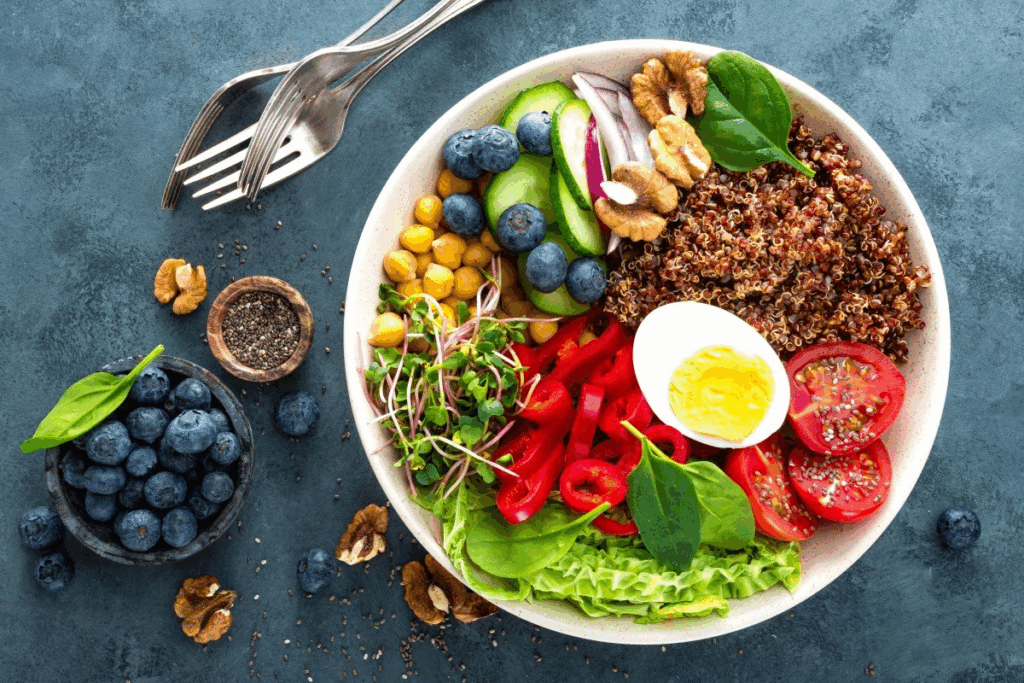
After gastric sleeve surgery, many patients wonder about their diet. At Liv Hospital, we offer personalized advice to help you choose the right foods. This is key to your recovery and weight loss.
Seeing big weight losses, like Billy Gardell’s, shows the surgery’s power. As you heal, it’s important to eat the right foods at the right time. We suggest starting with soft fruits 4-6 weeks after surgery.

Gastric sleeve surgery changes your stomach size and how your body processes food. It’s key to understand these changes for a good recovery and health. We’ll see why eating right is not just suggested but needed.
The surgery makes your stomach smaller, like a sleeve. This change affects how you eat and digest food. With a smaller stomach, you can’t eat as much at once. The way your body absorbs nutrients also changes.
After surgery, your body can’t digest some foods as easily. You might need to avoid foods that were once easy to eat. Paying attention to your body’s signals is important for a smooth transition.
Following a diet plan after surgery is very important. Dr. Surya Bhagwati says each person’s recovery is different. Starting with liquids and slowly adding solids helps avoid discomfort and problems.
Going through diet stages slowly helps your body adjust. This careful approach supports healing and helps maintain nutritional balance in the long run.
As you move through diet stages, listen to your body and adjust as needed. A tailored diet plan, with professional help, ensures you eat well without discomfort.

After gastric sleeve surgery, patients follow a structured diet. This helps the stomach heal and adjust to the new digestive system.
The first stage is the liquid diet, lasting 1-2 weeks. Patients should eat clear liquids and then thicker ones. Suitable foods include:
Next, patients move to pureed foods, starting 2 weeks after surgery. Foods are blended for easy digestion. Examples include:
By 4-6 weeks, patients can eat soft foods. These should be tender and easy to chew. Examples include:
To show the diet progression, here’s a summary table:
| Phase | Duration | Examples of Foods |
| Liquid Phase | 1-2 weeks | Broth, clear soups, water, herbal teas, protein shakes |
| Pureed Foods Phase | 2-4 weeks | Pureed vegetables, mashed fruits, yogurt, protein-rich pureed foods |
| Soft Foods Phase | 4-6 weeks | Soft-cooked vegetables, ripe fruits, soft proteins, soft whole grains |
Following this diet progression is key to healing and avoiding complications. It helps patients adjust to their new stomach size and get the nutrients they need.
After gastric sleeve surgery, it’s important to know when to add fruits back into your diet. This is a gradual process. It helps avoid discomfort and ensures you get the nutrients you need.
Most patients can start with soft fruits around 4-6 weeks after surgery. This is when you’re eating soft foods.
At 4-6 weeks, you can start with soft fruits. These are easy to digest. Examples include:
Start with small portions and watch how your body reacts. It’s important to chew thoroughly and eat slowly. This helps with digestion.
By 8 weeks, you might be ready for raw fruits. But do this slowly and with your doctor’s advice. Start with soft fruits like ripe mangoes or avocados.
When you move to raw fruits, keep an eye on portion sizes and eat mindfully. Raw fruits can be harder to digest. So, listen to your body and adjust as needed.
Adding fruits back into your diet after gastric sleeve surgery is a big step. It helps you eat a varied and nutritious diet. By following these tips and talking to your healthcare team, you can enjoy fruits while supporting your health and recovery.
After gastric sleeve surgery, it’s key to eat fruits that are easy to digest and full of nutrients. As you move through your diet plan, adding the right fruits can boost your nutrition and aid in recovery.
Bananas are great for early recovery because they’re soft and packed with nutrients. They’re full of potassium, which is good for blood pressure and muscles. Choose ripe bananas for easier digestion and less discomfort.
Nutritional Benefits of Bananas:
Canned and stewed fruits are also good choices in the 4-8 week period after surgery. They’re soft and easy to digest, perfect for those moving from a liquid diet. Choose fruits canned or stewed in natural juice without added sugars for more nutrition.
Benefits of Canned and Stewed Fruits:
Soft-cooked fruits like apples or pears are also recommended. Cooking them until tender makes them easier to digest. Remove the skins to avoid digestive issues. These fruits offer important vitamins and fiber, helping your health and recovery.
Tips for Preparing Soft-Cooked Fruits:
After gastric sleeve surgery, patients can start eating raw fruits at 8 weeks. This is a big step towards a more varied and healthy diet.
Strawberries are a favorite for many, but timing varies. Generally, soft and ripe strawberries can be introduced around 8 weeks after surgery. Always watch how your body reacts and adjust as needed.
Begin with small amounts and chew well to help with digestion. If you feel bloated or in pain, slow down or talk to your doctor.
Berries and melons can also be added around 8 weeks. They’re tasty and full of nutrients.
Some fruits, like apples or pears, might be harder to digest. They have tough skins and a lot of fiber.
Here’s what to do:
By listening to your body and slowly adding new fruits, you can enjoy a wide range of healthy foods. This supports your health and well-being after surgery.
After gastric sleeve surgery, it’s key to learn how to eat fruit properly. Fruits are full of vitamins, minerals, and fiber, making them great for your diet. But your stomach needs time to heal, so you must eat fruits carefully.
Knowing proper portion sizes is important when eating fruit after surgery. Eating too much fruit at once can upset your stomach. Start with small amounts, like 1/4 cup or 1 ounce, and slowly increase as you can.
“The American Heart Association says a serving of fruit is about 4 ounces or 1/2 cup,” which is good for post-surgery eating. “Watching portion sizes helps control calories and ensures you get the nutrients you need without overwhelming your stomach.”
It’s also important to chew your fruit well and eat slowly. This makes it easier for your stomach to digest, lowering the chance of nausea or blockage. We suggest chewing each fruit bite until it’s almost liquid before swallowing.
Knowing the signs of intolerance is vital when adding fruits to your diet after surgery. Symptoms like bloating, gas, diarrhea, or pain in your belly might mean you’re not tolerating a fruit well. If you notice these signs, stop eating that fruit and talk to your doctor.
One patient found that apples made them uncomfortable, but bananas and other soft fruits worked better. This shows how important it is to listen to your body and adjust your diet.
By following these tips and paying attention to how your body reacts, you can enjoy fruits’ health benefits while avoiding risks. Always get advice from your healthcare provider or a dietitian on adding fruits to your diet after surgery.
Fruits are key for those who have had gastric sleeve surgery. They offer important nutrients that help with health and recovery.
Fruits are packed with vitamins and minerals that are vital for health after surgery. Oranges and grapefruits are full of vitamin C, which boosts the immune system and aids in healing. Berries are loaded with antioxidants and fiber, and bananas give you potassium, which is good for your heart and muscles.
| Fruit | Key Nutrient | Health Benefit |
| Oranges | Vitamin C | Boosts the immune system |
| Berries | Antioxidants, Fiber | Supports heart health, aids digestion |
| Bananas | Potassium | Essential for heart health and muscle function |
Fruits are good, but they have natural sugars that can affect blood sugar and calorie intake. Gastric sleeve patients need to balance fruits with other healthy foods. Opt for fruits like berries and citrus that are low in sugar and high in fiber to manage sugar intake and get the nutrients you need.
Tips for Balancing Natural Sugars:
By adding a variety of fruits to their diet and monitoring their sugar levels, gastric sleeve patients can enjoy the benefits of fruits. This supports their health and recovery.
After gastric sleeve surgery, adding fruits back into your diet can be tough. Fruits are full of nutrients and fiber, but adding them too fast can cause problems. It’s important to do it slowly and carefully.
One big issue is feeling uncomfortable after eating fruits. This might include bloating, gas, or stomach pain. To avoid this, start with small amounts of soft, cooked, or canned fruits.
It’s also key to watch how your body reacts to different fruits. Some, like berries or apples, can be harder to digest. Keeping a food diary can help figure out which fruits are okay and which aren’t.
Another big challenge is dealing with the sugar in fruits to prevent dumping syndrome. Dumping syndrome happens when sugar-rich foods move too fast through your system. Choose fruits that are low in sugar and high in fiber to avoid this.
| Fruit | Sugar Content (g) | Fiber Content (g) |
| Apple | 19 | 4.5 |
| Banana | 14 | 3.1 |
| Berries (1 cup) | 7-15 | 3-4 |
There are many ways to add fruits to your diet after gastric sleeve surgery. You can blend them into smoothies or protein shakes. Cooking fruits into compotes or stews can also make them easier to eat.
Try different ways of preparing fruits, like grilling them or adding them to savory dishes. The goal is to slowly add more fruits to your diet.
By understanding the challenges and using these tips, you can successfully add fruits back into your diet. This will improve your nutrition and overall health after gastric sleeve surgery.
Fruits can be a great addition to your diet after gastric sleeve surgery. They are healthy and can make your meals more enjoyable. Knowing when and how to eat fruits can help you get the most benefits without discomfort.
Research shows that eating fruits and veggies regularly helps bariatric surgery patients do well long-term. Adding fruits to your healthy lifestyle supports your weight loss and improves your overall health.
Try different fruits and add them to your meals every day. This step is key to achieving long-term success and enjoying a balanced diet’s many benefits.
You can start with soft fruits 4-6 weeks after surgery. Raw fruits are usually okay around 8 weeks.
Bananas, canned fruits, and soft-cooked fruits are great early on. They’re easy to digest and full of nutrients.
Strawberries are okay around 8 weeks, when you can handle raw fruits. Chew well and start with small amounts.
Eat fruits in small amounts, chew well, and eat slowly. Watch for signs of discomfort or dumping syndrome and adjust as needed.
If you feel uncomfortable, try eating less or cooking fruits. Also, try different fruits to see what works best for you.
You might face digestive issues, dumping syndrome, or sugar problems. Start slow, choose easy fruits, and balance with other foods.
Fruits are good, but watch the sugar. Opt for lower sugar fruits like berries and control your portions to avoid dumping.
Mix fruits into meals or snacks in new ways. Blend into smoothies, add to yogurt, or top oatmeal or salads. It makes eating fruits fun and easy.
Bettini, S., Sibilio, G., Campana, R., & Zamboni, M. (2020). Diet approach before and after bariatric surgery. Nutrients, 12(2), 321. https://pmc.ncbi.nlm.nih.gov/articles/PMC7455579
Subscribe to our e-newsletter to stay informed about the latest innovations in the world of health and exclusive offers!
WhatsApp us